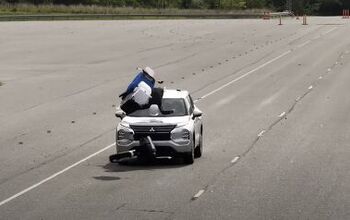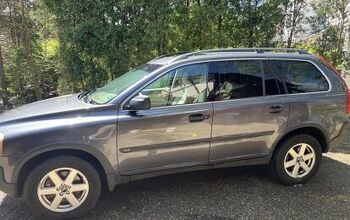NHTSA Launching Investigation Into Chevy Bolt Fires

According to the very people trying to sell them, electric vehicles are slated to become the hottest commodity on the automotive market since the Ford Pinto, Pontiac Fiero, or Ferrari 458 Italia. But, following a swath of highly publicized fires, there’s been this creeping narrative that there may be some unaddressed safety concerns pertaining to EVs. Numerous video clips of vehicles spontaneously combusting in Asia and local media reports of phantom garage fires in North America have helped feed the story, with regulators now taking accusations of battery flambé extremely seriously.
Case in point is the National Highway Traffic Safety Administration’s new investigation into the Chevrolet Bolt. The agency’s Office of Defects Investigation received just two complaints regarding 2018 and 2019 Bolts that were alleged to have caught fire in a similar manner. But lids were flipped when the NHTSA realized it had seen a 2017 model with a similar burn pattern working its way up through the rear seat. The group is now launching a preliminary evaluation to decide whether these were freak accidents or if the Chevy Bolt actually has a tendency to catch fire while nobody is around.
It might also be nice for regulators to nip any EV fire hazards in the bud before they become the dominant form of personal conveyance. While reports of battery fires routinely get more media attention than the banged-up Buick Century I saw burning on the Henry Hudson Parkway over the weekend, there’s not supposed to be much of a difference in the frequency of gasoline and battery-related car fires. But regulators seem terrified that won’t remain true as more battery-driven vehicles enter the marketplace. Automakers are no less concerned because absolutely nobody wants to be the brand with the famously dangerous EVs.
General Motors informed us that it was aware of the preliminary examination and intended on cooperating with the investigation fully, as well as launching its own to make doubly sure there’s no doubt about what is/isn’t happening with the Bolt.
Automotive News, which first caught wind of investigation PE 20-016, said the NHTSA reported that “the fire damage appeared to be concentrated in the EV battery compartment area with penetration into the passenger compartment from under the rear seat,” but that nothing conclusive had been determined at this juncture.
From AN:
U.S. safety regulators will evaluate the cause of the fires as well as the scope, frequency and consequence of the alleged defect.
Most NHTSA investigations start as preliminary evaluations, where agency engineers request information from the manufacturer, including data on complaints, injuries and warranty claims. The manufacturer can also present its view regarding the alleged defect and may issue a recall.
After the evaluation, NHTSA will either close the investigation or move into the next phase. If a safety-related defect exists, according to NHTSA, the agency may send a “recall request” letter to the manufacturer.
A lot of the concerns pertain to the unique dangers of battery fires — something we recently covered following a report from the National Transportation Safety Board (NTSB) claiming most U.S. fire departments couldn’t handle them. The NTSB has been cracking down on newer automotive technologies in general but has recently focused on electric vehicle fires as manufacturers gear up to dump countless new models into various markets over the next few years.
[Image: Chevrolet]

A staunch consumer advocate tracking industry trends and regulation. Before joining TTAC, Matt spent a decade working for marketing and research firms based in NYC. Clients included several of the world’s largest automakers, global tire brands, and aftermarket part suppliers. Dissatisfied with the corporate world and resentful of having to wear suits everyday, he pivoted to writing about cars. Since then, that man has become an ardent supporter of the right-to-repair movement, been interviewed on the auto industry by national radio broadcasts, driven more rental cars than anyone ever should, participated in amateur rallying events, and received the requisite minimum training as sanctioned by the SCCA. Handy with a wrench, Matt grew up surrounded by Detroit auto workers and managed to get a pizza delivery job before he was legally eligible. He later found himself driving box trucks through Manhattan, guaranteeing future sympathy for actual truckers. He continues to conduct research pertaining to the automotive sector as an independent contractor and has since moved back to his native Michigan, closer to where the cars are born. A contrarian, Matt claims to prefer understeer — stating that front and all-wheel drive vehicles cater best to his driving style.
More by Matt Posky
Latest Car Reviews
Read moreLatest Product Reviews
Read moreRecent Comments
- Arthur Dailey Agree with @Jeff, if you needed a cheap vehicle that was relatively robust and last a long time and you did not care about driving dynamics you could do worse than a J-Car. They as the saying go, drove badly, for a long time. They were less rust prone than many Japanese imports, and either more reliable or more robust than many (most) European or Korean autos. And parts were cheap and repairs relatively simple. As he writes, we complain about the lack of inexpensive, basic autos but then criticize autos that were inexpensive and basic. As the saying goes 'you can get cheap, fast or good, but you cannot get all 3 in the same product'.
- Bd2 Overpriced food, awful home furnishings, endless assortments of sugary candy and drinks which are mostly garbage and childish gimmicks galore. Indeed, the most "American" of traditions.
- SCE to AUX Some pretty big strikes:[list][*]Drivetrain - how can a straight-6 be thrashy? Shame on you, Mazda.[/*][*]Poor fuel economy.[/*][*]Tire noise.[/*][*]Poor user interface.[/*][*]That colored dash is a bit garish for me.[/*][*]High price.[/*][*]Indistinct look in the Mazda lineup. Their SUVs are Russian nesting dolls.[/*][*]Nothing compelling to lure a buyer away from the bigger brands.[/*][/list]I don't see this moving the needle for Mazda in the US market.
- Ash78 Dear unions, thank you for your service and for expressing interest in our automotive factories. Due to your many decades of pressuring employers to do better, the more adept companies have gotten your message and have implemented most of your demands preemptively in order to maintain a better employer-employee relationship than the manufacturing industry as a whole.We truly appreciate your feedback and interest, and all it has done to improve employer relations since the industrial revolution. We take your concerns seriously and will be glad to reach back out if our situation changes.We will keep your resume on file for three years, per company policy.Sincerely,Everyone
- Theflyersfan I'm having a tough time figuring out Mazda's recent lineup decisions. I've mentioned before how having the CX-5 and CX-50 makes no sense as it seems like they would steal each other's sales instead of conquest sales from other brands. And now here comes the CX-70 vs 90 decision. If Mazda wanted to position the 70 above the 90 with pricing, I think they should have gone the Audi Q7 vs Q8 route. The Q8 costs more, has one fewer row, and is smaller on the inside, but has the more aggressive styling and tries to position itself as the sportier alternative large CUV in their lineup. With Mazda, the 70 and 90 seem to be in the position, like the 5 vs 50, to steal each other's sales. There isn't anything compelling me to get a 70 if I get more for my money with a 90, except 100,000 miles down the road, I won't have a folded up third row seat rattling around loosely. Mazda should have brought over the CX-60 and position that where they wanted the 70. I understand it's a touch larger than the X3, Q5, and GLC CUVs, which is a sweet spot in that market. Make the CX-70 a sportier alternative 2-row instead of such a blatant cynical move of just ripping a seat out of the 90, calling it an all new model and price it in the same ballpark. I want Mazda to succeed and continue to be independent, but decisions like these make me wonder what their future plans are.


































Comments
Join the conversation
The following documentary clip rather vividly demonstrates a very typical real-world scenario which results when self-driving technology is combined with internal combustion/liquid fuels. Note: Language advisory (and other unpleasantness). https://tinyurl.com/y33jqxlx
It is tragic GM is betting the company on a lost cause like the Bolt.